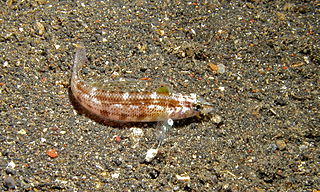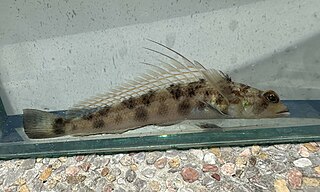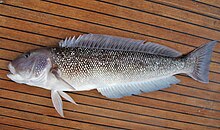
The sandperches are a family, Pinguipedidae, of fishes in the percomorph order Trachiniformes. Sandperches are benthic fish which normally occur over sand or rubble substrates in shallow seas. They are found off the coasts of South America, South Africa and in the Indo-Pacific as far east as Japan. The family contains a few species which are used by humans for food.

Parapercis is a genus of sandperches belonging to the family Pinguipedidae.

Parapercis maculata, the harlequin sandperch, is a species of marine ray-finned fish in the family Pinguipedidae, found in shallow waters in the tropical western Indo-Pacific Ocean.

Pinguipes is a small genus of sandperches belonging to the family Pinguipedidae found in waters off South America.
Prolatilus is a monotypic genus of labriform ray-finned fish from the family Pinguipedidae. The only species in the genus, Prolatilus jugularis, the Pacific sandperch, is found in the south eastern Pacific of the coast of Peru and Chile. It occurs over rocky and sandy bottoms and feeds on crustaceans, polychaetes and small fish. This species is considered to be good quality food fish and is commercially exploited.
Parapercis albipinna is a ray-finned fish species in the sandperch family, Pinguipedidae. It is found in New Caledonia. This species reaches a length of 14.2 cm (5.6 in).
Parapercis compressa is a ray-finned fish species in the sandperch family, Pinguipedidae. It is found in Indonesia. This species reaches a length of 8.7 cm (3.4 in).
Parapercis diagonalis, the diagonal sandperch, is a ray-finned fish species in the sandperch family, Pinguipedidae. It is found in Indonesia. This species reaches a length of 15.0 cm (5.9 in).
Parapercis flavolineata, the yellowline sandperch, is a ray-finned fish species in the sandperch family, Pinguipedidae. It is found in Indonesia. This species reaches a length of 14.0 cm (5.5 in).
Parapercis shaoi is a ray-finned fish species in the sandperch family, Pinguipedidae. It is found in Taiwan. This species reaches a length of 15.3 cm (6.0 in).
Parapercis vittafrons, the bandhead sandperch, is a ray-finned fish species in the sandperch family, Pinguipedidae. It is found in Papua New Guinea. This species reaches a length of 9.0 cm (3.5 in).
Parapercis australis is a ray-finned fish species in the sandperch family, Pinguipedidae. It is found in Queensland, Australia and the island of Tonga. This species reaches a length of 9.2 cm (3.6 in).

Parapercis lineopunctata, the nosestripe sandperch, is a ray-finned fish species in the sandperch family, Pinguipedidae. It is found in the islands of Sumatra, Sulawesi, the Philippines, in Australia, on the Great Barrier Reef, the Solomon Islands and remote Lord Howe Island. This species reaches a length of 7.4 cm (2.9 in).
Parapercis rufa, the red sandperch, is a ray-finned fish species in the sandperch family, Pinguipedidae. It is found in the Philippines. This species reaches an unknown length.
Parapercis biordinis is a ray-finned fish species in the sandperch family, Pinguipedidae. It is found in Western Australia and the Philippines.

Parapercis filamentosa, the threadfin sandperch, is a species of ray-finned fish in the sandperch family, Pinguipedidae. It is found in the western Pacific Ocean including Hainan, China and south to Thailand and Indonesia.

Parapercis pulchella, the harlequin sandsmelt, is a ray-finned fish species in the sandperch family, Pinguipedidae. It is found in the north-western Pacific Ocean, including the shores of Japan, Taiwan and Hong Kong.
Parapercis rubromaculata, the redspot sandperch, is a species of ray-finned fish in the sandperch family, Pinguipedidae. It is found in Taiwan.
Parapercis kentingensis, the Kenting sandperch, is a species of ray-finned fish in the sandperch family, Pinguipedidae. It is found in China, Taiwan and Japan.
Parapercis flavescens is a species of ray-finned fish in the sandperch family, Pinguipedidae. It is found in New Caledonia.







